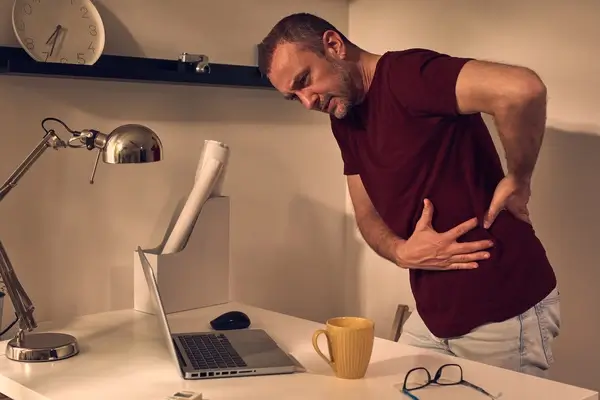Estimated reading time: 4 minutes
A hernia is a relatively common condition that affects millions of people across the UK. The symptoms and signs vary depending on the location and severity of the hernia.
If you think you might have one, find out what a hernia feels like so you can seek the right treatment.

Private hernia repair surgery at a glance
- Waiting time: 4-6 weeks
- Cost: £3,299
- Ways to pay: self-pay, insured, payment plans
On this page:
Key hernia symptoms include a visible lump, varying degrees of pain or discomfort, and a feeling of pressure. Medical consultation is essential for diagnosis, as a specialist may recommend hernia repair surgery.
Wellsoon private healthcare
Wellsoon is a service from Practice Plus Group that provides a range of treatments for patients paying for themselves or paying by private medical insurance. With no hidden costs, you’ll pay less than you might think and be back to your best sooner than you thought.
- £95 consultation within 1 to 2 weeks* – includes x-ray, bloods and swabs
- Surgery in just 4 to 6 weeks*
- Experts in hips, knees, eyes, hernias and more
- Pay for yourself or via health insurance
- 0% finance options available

What are the first signs of a hernia?
A hernia occurs when part of an organ or fatty tissue pushes through a weak spot in the surrounding muscle or tissue. This creates a bulge or protrusion. If you’re experiencing pain or discomfort in your tummy or groin area, it’s possible that you may be suffering from a hernia.
But what does a hernia feel like? Below are some of the most common symptoms:
- A bulge or swelling – the most obvious sign of a hernia is a bulge or swelling in the affected area. In some cases, this bulge may be visible. In others, it may only be felt when you touch the affected area
- Pain or discomfort – hernias can cause varying degrees of pain. Some people may only experience a mild ache or discomfort, while others may feel sharp, intense pain
- Pressure or a feeling of fullness – you may feel a sensation of pressure or fullness in the affected area, especially when standing or lifting heavy objects
- Nausea or vomiting – in some cases, a hernia can cause nausea or vomiting, especially if it is causing an obstruction in the digestive tract
- Difficulty passing urine – this symptom is especially found in men. The hernia can sometimes press on the bladder or urethra, making it difficult to pass urine.
Where can you get a hernia?
A hernia can occur in various parts of the body where there is a weakness or a gap in the muscle or tissue. The most common areas where hernias occur include the tummy, groin, and upper thigh.
Hernias can also occur in other parts of the body, such as the diaphragm, the area around the belly button, and the site of a previous surgical incision (this type is called an incisional hernia).
What does a hernia look like?
In most cases, a hernia looks like a visible bulge or swelling in the affected area. For example, an inguinal hernia in the groin area may appear as a small lump that can be felt or seen when standing or coughing. An umbilical hernia around the belly button may cause a visible protrusion when you strain or cough.
A hernia may be more noticeable when doing heavy lifting, coughing, or during physical activity.
It’s important to note that not all hernias are visible or noticeable, especially if they are small or internal. In these cases, a doctor or healthcare provider may need to perform imaging tests or physical exams to diagnose the hernia.
If you suspect that you may have a hernia or are experiencing symptoms such as pain, discomfort, or pressure in the affected area, it’s important to seek medical advice as soon as possible. A healthcare provider can diagnose the hernia and recommend the appropriate treatment. This may include hernia repair surgery.
Different types of hernia and their symptoms
As we’ve briefly mentioned, there are several different types of hernias. Here we take a look at the different signs and symptoms of the more common types.
What does a hiatus hernia feel like?
A hiatus hernia occurs when the upper part of the stomach bulges through an opening in the diaphragm and into the chest. This type of hernia can cause a variety of symptoms. These may include:
- Heartburn – a hiatus hernia can cause stomach acid to reflux into the oesophagus, leading to a burning sensation in the chest and throat
- Chest pain – some people with a hiatus hernia may experience chest pain, which can be mistaken for a heart attack
- Difficulty swallowing – a hiatus hernia can cause narrowing of the oesophagus, making it difficult to swallow
- Acid reflux – acid reflux occurs when stomach acid flows back into the oesophagus, causing a sour taste in the mouth and a burning sensation in the throat
- Shortness of breath – a large hiatus hernia can push on the lungs, making it difficult to breathe.
Can you feel a hiatus hernia with your fingers?
Hiatus hernias are typically diagnosed via imaging tests (x-rays, CT scans, or endoscopy) rather than by touch or feel.
What do stomach hernias feel like?
Stomach hernias can cause a variety of symptoms. These may include:
- a visible bulge or lump
- pain or discomfort
- heartburn or acid reflux
- difficulty swallowing
- nausea or vomiting.
What does a groin hernia feel like?
A groin hernia (also known as an inguinal hernia) occurs when a portion of the intestine or abdominal tissue protrudes through a weakened area in the groin muscles. This type of hernia can cause a variety of symptoms. These may include:
- a visible bulge or lump – a groin hernia may cause a bulge or lump to appear in the groin area. This may be more noticeable when standing or straining
- pain or discomfort – a hernia can cause discomfort or pain in the groin area, particularly when coughing, bending, or lifting
- pressure or heaviness – some people with a groin hernia may experience a sensation of pressure or heaviness in the groin area
- weakness or fatigue – a hernia can cause weakness or fatigue in the abdominal or groin muscles, particularly after physical activity.
How do you know if you have a hernia?
If you have any of the symptoms listed above, you may have a hernia. The best way to find out for certain is to check with your doctor.
How do I check myself for a hernia?
Hernia self-diagnosis is not recommended and it’s always best to speak to a healthcare provider if you are experiencing any symptoms or concerns about your health.
However, there are steps you can take to check for a hernia at home:
- Stand in front of a mirror and examine the affected area. Look for any visible bulges or lumps, particularly when you cough or strain
- Gently feel the affected area with your fingers to check for any protrusions or abnormalities. You may want to lie down and press gently on the area to feel for any lumps or bumps
- Take note of any pain, discomfort, or other symptoms you may be experiencing, and when they occur. This information can be helpful when speaking to a healthcare provider.
Getting a hernia diagnosis
Here’s what you can do to get a hernia diagnosis:
- The first step is to make an appointment with your GP. Your GP will conduct a physical exam and ask about your symptoms
- Your GP may recommend imaging tests, such as an ultrasound or CT scan, to confirm a hernia diagnosis. These tests can help your GP determine the size and location of the hernia
- Depending on the severity and location of the hernia, your GP may refer you to a hernia specialist.
The appropriate treatment will depend on a number of factors such as the type and severity of hernia and how much it is impacting your quality of life. For example, if you have certain risk factors that make hernia surgery high risk, or if the hernia is likely to become a strangulated hernia or an incarcerated hernia which can be life-threatening.
Hernia FAQs
If you haven’t found what you’re looking for, our dedicated hernia FAQs may be able to help!
There are other conditions that can be mistaken for a hernia. These conditions can cause similar symptoms, such as pain, swelling, or a visible bulge in the affected area:
- Strained muscle: These can cause pain and swelling in the affected area. Unlike a hernia, a strained muscle does not usually cause a visible bulge
- Lipoma: A benign growth of fatty tissue that develops under the skin, a lipoma can cause a visible lump. It isn’t usually painful
- Hydrocele: A buildup of fluid around the testicle which can cause swelling and discomfort. This condition can be mistaken for a hernia because it can cause a visible bulge in the scrotum
- Varicocele: A varicocele is a swelling of the veins in the scrotum, which can cause discomfort and a visible bulge. This condition can be mistaken for a hernia because it can be felt as a lump in the scrotum
- Enlarged lymph nodes: In the groin area, these can cause swelling and discomfort, which can be mistaken for a hernia
Yes. It is possible to have a hernia without a visible lump or bulge. This type of hernia is often known as a “hidden” or “occult” hernia. Instead of a visible bulge, a hidden hernia can cause symptoms such as pain in the affected area, or a feeling of pressure or heaviness.
Hidden hernias are usually diagnosed with imaging tests such as an ultrasound or CT scan. In some cases, a healthcare provider may need to perform a physical exam while you are straining or coughing to detect the hernia.
A hernia may feel like a soft bulge or lump. The bulge may be painful, tender or uncomfortable to touch and may become more prominent when you cough or strain.
The texture of the bulge may vary depending on the type of hernia and the tissue that is protruding through the weakened area. For example, an inguinal hernia in the groin area may feel like a soft, spongy bulge, while a hiatus hernia in the upper abdomen may feel like a firmer, more solid mass.
It’s important to note that not all hernias can be felt or seen, and some may only cause symptoms such as pain or discomfort without a visible bulge. If you suspect you may have a hernia or are experiencing any symptoms in the affected area, it’s best to seek medical advice from a healthcare provider.
The texture of a hernia can vary depending its type and the tissue that is protruding through the weakened area.
For example, an inguinal hernia in the groin area may feel like a soft, spongy bulge that is compressible and can be pushed back into the tummy. However, if the hernia becomes incarcerated or strangulated, it can become hard, firm, and painful to the touch.
On the other hand, a hiatus hernia in the upper abdomen may feel like a firm, solid mass, as it involves the protrusion of the stomach through the diaphragm.
Hernia pain can feel different for each person and varies depending on its type and location. Some common characteristics of hernia pain include:
- dull or sharp pain
- discomfort or pressure
- burning or tingling sensation
- pain during physical activity
- radiating pain.
Although uncommon, nausea isn’t unheard of when it comes to hernia symptoms.
It is possible for a hernia to make you feel tired, although this is not a common symptom of hernias.
For example, if the hernia is causing discomfort or pain, this can disrupt your sleep and cause you to feel tired during the day. In addition, hernias that are causing digestive symptoms, such as nausea or difficulty swallowing, can also lead to fatigue and weakness.
Yes, a hernia can make you feel bloated. Hernias that occur in the abdominal region (e.g. umbilical, ventral or inguinal) can cause a sensation of bloating or fullness in the affected area. This is because the hernia puts pressure on the surrounding tissues and organs, leading to a feeling of discomfort.
In addition, hernias that cause digestive symptoms, such as acid reflux or constipation, can also cause a feeling of bloating or fullness in the tummy.
It is not common for a hernia to cause dizziness. However, in rare cases, a hernia that is large and puts pressure on nearby blood vessels or nerves may cause dizziness or lightheadedness. This is more likely to occur with hiatus hernias, which are located in the upper part of the stomach and can affect the blood flow to the heart.
It’s important to note that there are many potential causes of dizziness, and a hernia may not be the culprit. If you are experiencing persistent dizziness or lightheadedness, it’s best to seek medical advice from a healthcare provider to diagnose the underlying cause of your symptoms.
The symptoms of a hernia can be similar for both men and women. However, the specific sensation or discomfort may vary depending on its location.
For women, hernias that occur in the abdominal region (such as umbilical or ventral) may cause a visible bulge or protrusion in the tummy. This may cause a sensation of pressure, discomfort, or even pain in the affected area. Hernias in the groin area (inguinal hernias) may cause a bulge or lump in the groin that can also cause discomfort or pain.
In addition, hernias can cause digestive symptoms, such as nausea, vomiting, or difficulty swallowing. If the hernia is located in the upper part of the stomach (hiatusl hernia), it can cause acid reflux, heartburn, or chest pain, which can be felt by both men and women.
The good news is that hernias are usually treatable, especially if caught early. With the right treatment and care, most people are able to make a full recovery and return to their normal activities.
If you’re concerned about any symptoms you’re experiencing, don’t hesitate to speak to our team to learn more about hernia treatment and surgery.





